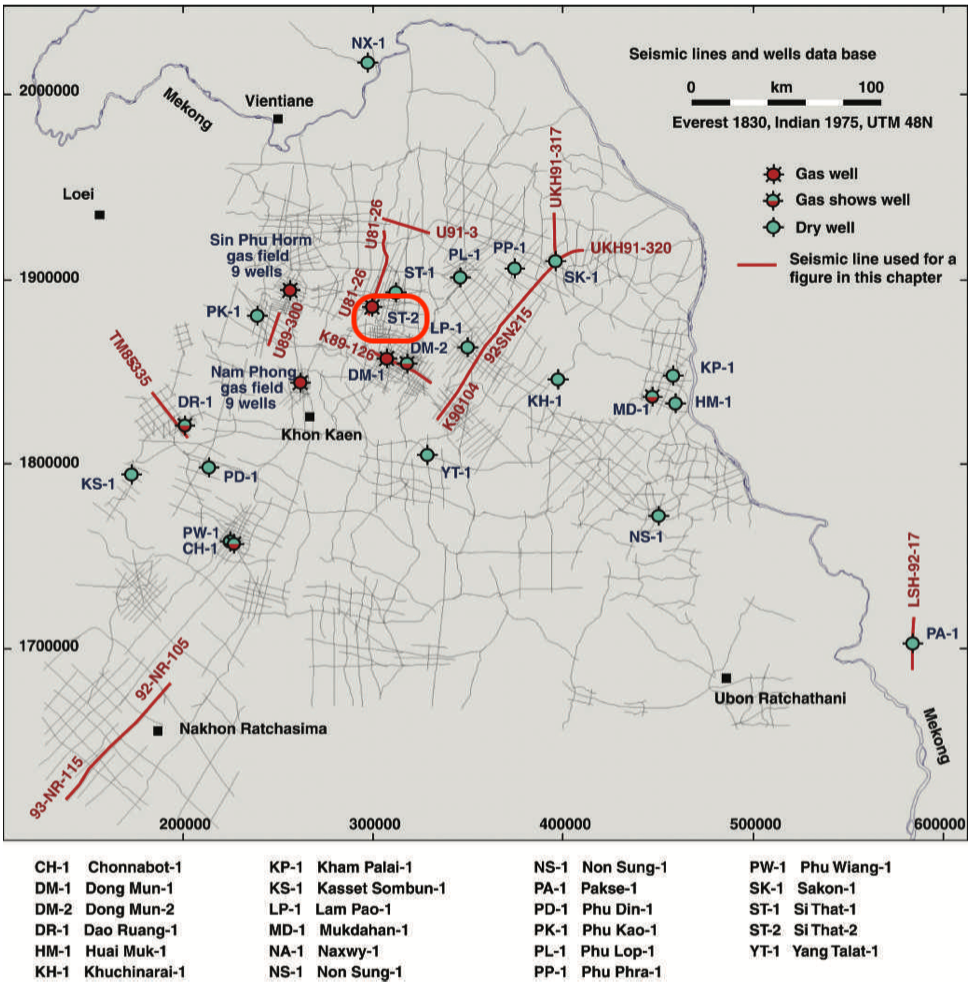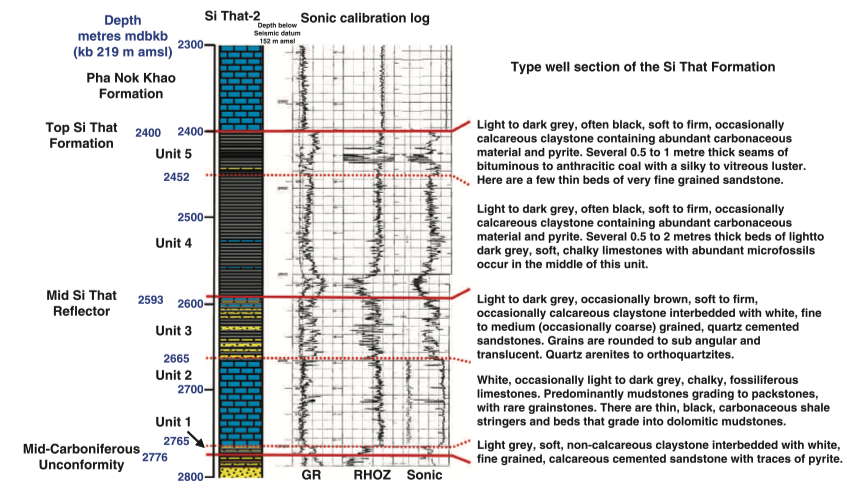Si That Fm
Type Locality and Naming
"The initial stratigraphic scheme for the subsurface of the Khorat Plateau proposed by the Department of Mineral Resources (DMR) applied the name Lower Clastics Formation to an interval of mixed siliciclastics and carbonates found below the massive platform carbonates of their Pha Nok Khao Formation. They did not designate a type section in a well. The name Si That Formation was first applied by Booth (1998), who proposed its type section in well Si That-2 (interval from 2400 to 2776 m). This name avoids confusion, since this so-called clastics formation is in many areas predominantly composed of thick intervals of carbonate." [Booth, J. & Sattayarak N., 2011, Chapter 9 Subsurface Carboniferous-Cretaceous geology of NE Thailand] Lowermost formation of the Saraburi Gr in this region.
Synonym:
[Figure: Location of hydrocarbon exploration wells in NE Thailand and seismic lines shown in other figures (Booth, J. & Sattayarak N., 2011, page 187).]
Lithology and Thickness
Mixed siliciclastics and carbonates. In the type well the formation can be divided into five lithological units: Unit 1 (gray marine shales); Unit 2 (100 m, white to gray limestones); Unit 3 (72 m, marl); [possible hiatus, then:] Unit 4 (140 m, dark grey to black carbonaceous shale to marl); Unit 5 (52 m, dark grey to black carbonaceous shale)
Relationships and Distribution
Lower contact
" Only five wells have been drilled below the Mid-Carboniferous Unconformity (Fig. 9.6). Two of them entered granites and the sedimentary sections penetrated by the other three are considered to be part of what is generally referred to in oil company reports as the ‘Loei Group’. … Unit 1, is considered to be part of the Si That Formation on the basis that the shales it contains are grey colored and probably marine in origin. This is in contrast to the underlying brown shales and multi-colored sandstones, below the Mid-Carboniferous Unconformity." [Booth, J. & Sattayarak N., 2011, Chapter 9 Subsurface Carboniferous-Cretaceous geology of NE Thailand]
Upper contact
Underlies the Pha Nok Khao Fm platform carbonates and the coeval open marine lateral equivalent of the Nam Duk Fm.
Regional extent
Khorat Plateau subsurface
GeoJSON
Fossils
Age
Depositional setting
"The lower part of the Saraburi group, the mixed siliciclastics and carbonates of the Late Carboniferous to Early Permian Si That Fm, were deposited in a variety of shelf marine to marginal terrestrial environments. … The overall impression is that after the Mid-Carboniferous Unconformity, deposition recommenced in shallow-marine to marginal terrestrial conditions. The water depth soon increased, but still remained relatively shallow throughout that period. In the center of the basin complex, initial sedimentation was mixed siliciclastics giving way very quickly to micritic limestones and then in turn to shales and subordinate sandstones. On the western flank of the basin a thicker section of mixed siliciclastics was deposited, succeeded by a thick section of micritic limestones and interbedded subordinate shales without the overlying shale and sandstone section seen in the basin center. " The upper part of this Si That Fm seems to reflect local lagoonal (the black shales/marls) to carbonate shelf settings. [Booth, J. & Sattayarak N., 2011, Chapter 9 Subsurface Carboniferous-Cretaceous geology of NE Thailand]
Additional Information
"On seismic lines in the vicinity of the type section in Si That-2 there is an obvious reflector (the Mid Si That Reflector) which divides the Si That Formation into two packages, each with distinctive internal reflection character. By tying this seismic pick into the type section it is seen to correspond to the boundary between Units 3 and 4. As discussed above, an Early Wesphalian to Late Namurian age was obtained from just below this boundary. The Mid Si That Reflector is therefore considered to have an early Late Carboniferous age." [Booth, J. & Sattayarak N., 2011, Chapter 9 Subsurface Carboniferous-Cretaceous geology of NE Thailand]

